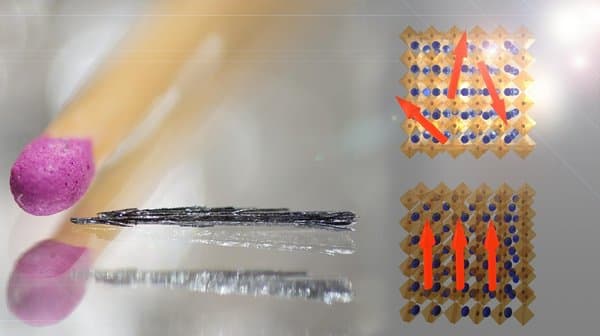A Perovskite Crystal Could Usher A Revolution In Data Storage
Now jewelry may bring a smile as well as important data as a group of researchers from the Ecole Polytechnique has recently reported being successful in implanting information inside a perovskite crystal. Small, feather-like crystal will soon be at your service with its modified HDD avatar, as suggested by its own publication house. Not so futuristic, but this also may require upgraded scientific tools for the industries to shape its full-scale customization and making.
The world has transformed into a storage hub and to house more information we need more storage devices with higher density and efficiency. Here, the devices or its original form must boast of a unique magnetic property that can be manipulated rapidly for the sake of data entry, storage, and reformation. The team came up with a ferromagnetic photovoltaic material where external light charges the electron to rapidly transfer the magnetic order, fulfilling the need for higher density information recording. And after this result, they guide us towards the world’s first magnetic photoconductor.

Perovskite and how things work inside
What’s their story? Let’s hear this with a touch of science in the background.
Led by postdoc Bálint Náfrádi, the project started with structuring a ferromagnetic photovoltaic material in the lab of Laszló Forró. The source claims, the brilliant minds are now inclined to Perovskite photovoltaics for its cheap availability in comparison to silicon systems. However, the newest outcome is somewhat different that makes it the apt choice for future generation storage devices.
In crude words, magnetism arises due to a particular orientation of electrons and to our best understanding, the pattern is material specific. This suggests the magnetic state cannot be reversed except by tinkering with its lattice structure. But what if an easy way could be defined? Scientists at EPFL preferred a hybrid path to combine ferromagnets with well-defined magnetic orientation and photoconductor that pushes high-density free conduction electrons. This peculiar amalgamation gave birth to a totally different phenomenon by melting the local magnetic order through Ruderman–Kittel–Kasuya–Yosida interactions.
In the experiment, a weak red LED source is used to melt the magnetic order and generate high density moving electrons with the control parameter. Although the research is in its nascent stage, it indicates towards high-capacity memory storage devices with lower energy consumption and cheaper fabrication. The complete research is published in the Nature Communications Journal.
Sources: #-Link-Snipped-# | #-Link-Snipped-#
The world has transformed into a storage hub and to house more information we need more storage devices with higher density and efficiency. Here, the devices or its original form must boast of a unique magnetic property that can be manipulated rapidly for the sake of data entry, storage, and reformation. The team came up with a ferromagnetic photovoltaic material where external light charges the electron to rapidly transfer the magnetic order, fulfilling the need for higher density information recording. And after this result, they guide us towards the world’s first magnetic photoconductor.

Perovskite and how things work inside
What’s their story? Let’s hear this with a touch of science in the background.
Led by postdoc Bálint Náfrádi, the project started with structuring a ferromagnetic photovoltaic material in the lab of Laszló Forró. The source claims, the brilliant minds are now inclined to Perovskite photovoltaics for its cheap availability in comparison to silicon systems. However, the newest outcome is somewhat different that makes it the apt choice for future generation storage devices.
In crude words, magnetism arises due to a particular orientation of electrons and to our best understanding, the pattern is material specific. This suggests the magnetic state cannot be reversed except by tinkering with its lattice structure. But what if an easy way could be defined? Scientists at EPFL preferred a hybrid path to combine ferromagnets with well-defined magnetic orientation and photoconductor that pushes high-density free conduction electrons. This peculiar amalgamation gave birth to a totally different phenomenon by melting the local magnetic order through Ruderman–Kittel–Kasuya–Yosida interactions.
In the experiment, a weak red LED source is used to melt the magnetic order and generate high density moving electrons with the control parameter. Although the research is in its nascent stage, it indicates towards high-capacity memory storage devices with lower energy consumption and cheaper fabrication. The complete research is published in the Nature Communications Journal.
Sources: #-Link-Snipped-# | #-Link-Snipped-#
Replies
You are reading an archived discussion.
Related Posts
In a bid to give a tough competition to Microsoft’s Surface Pro 4, Asus has unveiled a new very capable 2-in-1 laptop Transformer 3 Pro. The device with chassis crafted...
It's been 11 awesome years since CrazyEngineers went live on the Internet and it feels like all these years went by in the blink of an eye. Each of these...
On this day, 11 years back, our Administrator, the Founder & CEO of CrazyEngineers @Kaustubh Katdare setup this wonderful site that we all visit daily.
Incidentally, he chose his birthday...
We will be sharing all the tweets that we receive on CrazyEngineers Birthday to our official Twitter account here! 😀
We can't wait to read YOUR tweet!
Let the birthday...
Engineers are the most crazy species on the planet. We are known for doing really awesome stuff, build things, destroy things. We are the mask-less vigilantes who take it upon...
